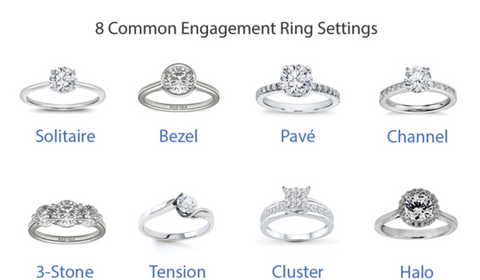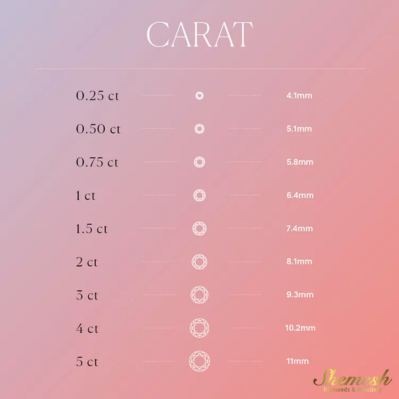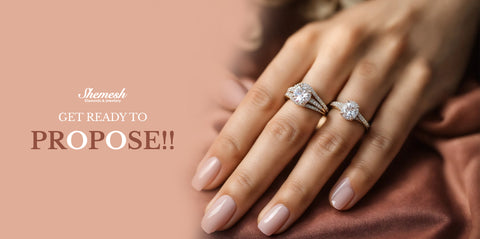
The Ultimate Guide to Choosing the Perfect Engagement Ring
Hello there!
Congratulations on reaching this exciting moment in your life! If you're reading this, chances are you're gearing up to pop the question and are on the hunt for that perfect engagement ring. We get it – choosing the right ring is a big deal! Before you take the plunge and make that special purchase, there are a few things you'll want to keep in mind.
Our Engagement Ring Guide is here to make this process a breeze for you. We've broken down the key factors to consider in a way that's easy to understand, without drowning you in confusing jargon. After all, this is a moment to savor, not stress over.
Let the ring hunt begin!
Budget Planning
Popping the question shouldn't break the bank. So, before you get swept away by sparkle, let's manage your budget responsibly. Read Our Budget Guide Here
Set your limit:
Ditch the outdated "two months' salary" rule. Be realistic. Consider existing finances, future goals, and a comfortable comfort zone. Aim for something you can pay off quickly, like under $2,000.
Prioritize the person:
Your partner's style and preferences reign supreme. Do they crave a classic solitaire or a vintage halo? Prioritize their favorite elements, be it the gemstone, setting, or metal. Compromise on non-essentials like carat size or clarity.
Gemstone alternatives:
Diamonds are only some of the people's favorite. Explore, a stunning and ethical alternative that sparkles even brighter, often exceeding a diamond's brilliance at a fraction of the cost.
Think outside the box:
Online retailers offer fantastic deals compared to traditional stores. Consider estate rings, family heirlooms, or even lab-grown diamonds for ethical and budget-friendly choices.
Prioritize Cut and Shape:
The cut and shape of a diamond significantly impact its appearance and cost. Cut determines the sparkle and brilliance, so aim for the best cut within your budget. Shape is personal, so choose what speaks to you. Deciding on these aspects first will save you money in the long run, preventing the desire to upgrade later.
Clarity and Color for the Naked Eye:
When it comes to clarity and color, remember that not all flaws are visible without magnification. Many consumers can't spot the difference between high and lower-end clarity diamonds. Opt for a lower-clarity stone that looks clear to the naked eye, saving you money without compromising beauty. The same goes for color; you don't necessarily need the highest grade if it looks good to you.
Good Polish is Good Enough:
The polish of a diamond refers to the smoothness of its surface. In most cases, a "good" polish is sufficient, as the difference between "good" and "excellent" is often indistinguishable to the naked eye. Save your budget by not splurging on unnecessary features.
Opt for White Gold:
While platinum is the preferred metal, white gold offers a fantastic and budget-friendly alternative. It has a similar appearance to platinum, is durable, scratch-resistant, and complements the diamond's brilliance. Choosing white gold over platinum can significantly cut down costs without sacrificing style.
Remember, the key to a successful budget-friendly engagement ring purchase is understanding your preferences, making informed decisions, and using technology to your advantage. Happy ring shopping!
Engagement Ring Setting and Style

What is an Engagement Ring Setting?
The setting refers to how gemstones are placed on the ring, showcasing the beauty of the engagement diamond.
Popular Settings:
Metal claws, known as prongs, hold the diamond in place. Four or six prongs are common.
Elevates the diamond, and allows significant light to pass through, timeless look.
Prongs may snag on materials, and require periodic inspection.
The diamond is encircled by metal, offering a modern look and enhanced protection.
Secure, sleek, and modern appearance.
May hide more of the stone, reducing light reflection.
The diamond appears suspended, held in place by the tension of the metal band.
Unique appearance, modern look, less maintenance.
Difficult to resize, may make a small carat weight look smaller.
Small diamonds are set between two horizontal channels of metal, often seen in wedding bands.
Secure, enhance sparkle, sleek design.
Requires more effort in cleaning, challenging to repair.
Popular Styles:
Solitaire Engagement Ring: Features a single diamond or gemstone, allowing it to shine as the focal point.
Pros: Timeless, versatile, focuses attention on the stone.
Cons: None significant.
Halo Engagement Ring: Surrounds the center stone with a circle of smaller diamonds, enhancing size and sparkle.
Pros: Boosts the appearance of a smaller diamond, and adds overall sparkle.
Cons: Tiny side stones may become loose.
Three Stone Ring: Features a center stone flanked by two smaller stones, symbolizing past, present, and future.
Pros: Maximizes sparkle, and allows personalization with different stone shapes.
Cons: Requires more cleaning than a single-stone design.
Vintage Engagement Ring:Inspired by historical eras, featuring intricate details and craftsmanship.
Pros: Radiates character and charm, and can match a specific period.
Cons: May require more cleaning due to intricate design.
Clusters stones tightly together to create the appearance of a larger stone.
Pros: Presents as a larger stone, unique look, lower cost option.
Cons: Requires more cleaning, smaller stones may become loose.
When choosing, it's essential to consider personal preferences, lifestyle, and budget. Additionally, staying updated on current engagement ring trends can provide valuable insights into popular styles.
The Difference Between Engagement Ring Settings and Styles
Ring styles and ring settings are two important aspects to consider when choosing an engagement ring. While they both contribute to the overall look of the ring, they serve different purposes.
Ring Styles:
Ring styles are the general design or appearance of the engagement ring. This includes features like the shape of the diamond or gemstone, the overall design of the band, and any decorative elements. Styles can vary widely, from classic and timeless to more modern or vintage-inspired. When you're exploring ring styles, you're essentially looking at the overall aesthetic that appeals to you, whether it's a simple solitaire or a more intricate design.
Ring Settings:
On the other hand, ring settings get into the technical details of how the diamond or gemstone is secured on the ring. The setting influences how the stone is positioned and held in place. For example, prong settings use small metal claws to grip the gem, while a bezel setting encircles the stone with a metal rim. The setting not only affects the security of the stone but also plays a role in how much light can enter and interact with the gem, influencing its brilliance.
In simpler terms, when you're talking about ring styles, you're discussing the overall look and vibe of the ring. When discussing ring settings, you're getting into the nitty-gritty details of how the stone is placed and secured on the ring.
Remember, finding the perfect engagement ring involves considering both the style that captures your heart and the setting that ensures your chosen gemstone is not only beautifully showcased but also securely held in place for a lifetime of wear. 
Engagement Ring Metal Selection
Let's talk about the metal types
According to a recent survey, 41% of engaged couples choose white gold for their rings. White gold looks similar to platinum but is made differently – it's a mix of yellow gold and alloys, finished with rhodium plating for that shiny appearance. While it's a durable and budget-friendly option, keep in mind that it may change color over time, requiring replating to maintain its original shine.
If you prefer a classic look, yellow gold might be your best bet. It's the purest gold option, making it hypoallergenic and easy to maintain. Yellow gold is also excellent for intricate settings, and it complements warmer skin tones and lower color-grade diamonds. The popularity of yellow gold is on the rise, with 15% of engagement rings featuring this timeless metal.
Rose gold, with its pinkish tint, adds a trendy touch to engagement rings. Made by combining gold, copper, and a bit of silver, the higher copper content gives it a more pronounced rosy hue. It's a great choice for those who want something different from traditional silver or gold. However, be cautious with rose gold-plated options, as they may tarnish over time. Opting for pure rose gold ensures durability and a longer-lasting finish.
Considered the most durable metal, platinum is a top choice for engagement rings. Platinum is known for its resistance to tarnishing, providing a secure setting for your precious stones. Keep in mind that it comes with a higher price tag due to its rarity and purity, but the investment pays off with minimal maintenance fees in the long run.
In summary, take your time exploring these options, and you'll surely find the perfect metal to symbolize your everlasting love.
Regardless of the metal you choose, Here are some universal care tips:
- Soak your ring overnight in white vinegar or soapy water to soften the buildup.
- Use a baby toothbrush for gentle cleaning.
- Invest in jewelry polishing clothes.
- Remove rings before using harsh chemicals, swimming, or engaging in activities that could damage the ring.
Ways to measure Ring Size at Home and Online.
Now, that you know so many details about engagement ring shopping, here’s another important aspect to keep a check on.
-
Use a Ring You Already Have
Start by grabbing a ring you currently wear on your left ring finger. Ensure it's a ring that fits comfortably. Print the ring size chart, place the ring over the circles, and align the inside edges with the closest circle. If between sizes, opt for the larger one.
-
With a Piece of String
Print the ring size chart and wrap a string around your ring finger, cutting it where it overlaps. Align it with the ring size guide, selecting the matching size. In case of uncertainty, choose the larger size.
While these methods are convenient, keep in mind that variations may occur due to printer settings or the string's stretch. Consider using multiple methods for accuracy. Many jewelers offer online tools or free ring sizers, so explore those options too.
Understanding Ring Sizes
Ring sizes are standardized in millimeters based on the inner circumference. However, the universality of sizes varies globally. The US and Canada use a numerical scale with half and quarter sizes, while other countries may follow an alphabetical scale or incorporate circumference adjustments. Different jewelers may also use distinct metrics, affecting size interpretation.
Is Ring Resizing available for all the designs?
Certain ring designs, like those with diamonds all around, can't be resized easily. Factors like these influence the accuracy of at-home sizing. If unsure, consult a local jeweler, especially when dealing with intricate designs.
What to do when sizing for the ring?
When in doubt, opt for a size up. Resizing a ring to make it smaller is simpler than enlarging it. This is especially useful in warmer climates where fingers may swell.
Secretly Finding Your Partner's Ring Size
To maintain the element of surprise, gather intel from family or friends. Pay attention to the jewelry your partner already wears. If all else fails, estimate by slipping their ring onto your finger or using a bar of soap to create a mold.
Diamond Shapes

Round:
Round-cut diamonds are the most popular and universally flattering. Their classic shape suits all hands, making them a safe and timeless choice. If you prefer a versatile and traditional look, a round diamond is a reliable option.
Emerald, Cushion, and Oval:
For those who appreciate subtlety and elegance, consider emerald, cushion, or oval-shaped diamonds. These shapes create a sophisticated and refined appearance. Oval diamonds, in particular, have gained popularity for their flattering look on any hand.
Princess and Radiant: Bold and Geometric:
If you're drawn to a more modern and geometric aesthetic, princess and radiant-cut diamonds are excellent choices. Their sharp lines and bold appearance make a statement, offering a contemporary twist to traditional engagement rings.
Pear, Marquise, and Heart:
For a romantic touch, consider pear, marquise, or heart-shaped diamonds. These distinctive shapes add a unique flair to your ring, symbolizing love and individuality. Pear-shaped diamonds, in particular, create the illusion of a longer, slender finger.
Now, let's delve into hand characteristics to help you find the perfect match:
Best for Smaller Hands or Short Fingers:
For petite hands or short fingers, opt for smaller-sized diamonds such as pear-shaped, marquise-shaped, or oval-shaped. These shapes create the illusion of a longer, slender finger. Choose thin bands to complement smaller hands, avoiding bands that are too wide, which can look awkward.
Best for Wider Fingers:
If you have wider fingers, embrace bolder and bigger rings. Fancy diamond shapes like ovals, marquise, teardrop, radiant cuts, or emerald cuts can create the illusion of a longer, slimmer hand.
Consider larger diamonds and go for medium to wide bands, as thin bands may make your hand look larger.
Best for Long Fingers or Skinny Hands:
With long, thin fingers, you have the freedom to choose any diamond shape. Larger stones will appear more proportional to your hand. Experiment with thicker, heavier bands, double rows of diamonds, and bold designs to enhance the elegance of long fingers.
Best for Square Fingers or Hands:
To balance the squareness of your hand, choose oval-cut, marquise-cut, or pear-cut diamonds. Avoid square-shaped diamonds like princess or Asscher cuts, as they can amplify the square shape of your fingers. Classic side stone engagement rings can add a feminine touch to square hands.
Best for Large Knuckles:
Those with large knuckles should consider wide, ornate bands to distract from the knuckles. Rings with a split shank or double rows of diamonds can also be flattering.
Remember, there are no strict rules when it comes to choosing a diamond shape. Let your personal style and preferences guide you. If you're unsure, don't hesitate to seek assistance from Experts.
The 4C’s
The 4C's – cut, color, clarity, and carat weight – are essential factors to consider when selecting the perfect ring. Understanding these elements can help you make an informed decision that suits both your preferences and budget.
The 4C's of Engagement Rings:
Cut:

The cut of a diamond refers to how well it has been shaped and faceted. It directly influences the sparkle and brilliance of the stone. A well-cut diamond reflects light beautifully, creating a stunning visual impact. The cut is not about the shape of the diamond but rather how well the facets interact with light. A diamond with an excellent cut will appear more vibrant and lively.
Color:

The color of a diamond is graded on a scale from D (colorless) to Z (light yellow or brown). The less color a diamond has, the higher its value. While some prefer the classic sparkle of a colorless diamond, others may appreciate the warmth of a slightly tinted stone. Your choice of color depends on personal preferences and budget constraints. It's essential to find the right balance that suits your taste and represents your style.
Clarity:

Clarity measures the presence of imperfections or inclusions within a diamond. These imperfections can be visible under magnification, but the naked eye might not always detect them. The clarity scale ranges from Flawless (no inclusions visible under 10x magnification) to Included (inclusions visible to the naked eye). Choosing a diamond with a clarity grade that aligns with your budget and desired appearance is crucial. Keep in mind that minor imperfections may not be noticeable without magnification and can offer a more budget-friendly option.
Carat Weight:

Carat weight is the measure of a diamond's size. Larger diamonds generally have a higher carat weight and are often associated with greater value. However, it's essential to consider the other three C's alongside carat weight to ensure a well-balanced choice. Sometimes, a slightly smaller diamond with excellent cut, color, and clarity can appear more impressive than a larger stone with inferior qualities.
Choosing a Trustworthy Jeweler
At last, when picking out an engagement ring, it's super important to find a jeweler you can totally trust. So, make sure your jeweler is someone with expert training. They should be Okay with answering all your questions and explaining stuff about buying diamonds in simple words.
Get a Diamond Grading Report
When you're getting an engagement ring, it's smart to ask for a diamond grading report. But don't worry, it's not as complicated as it sounds. This report comes from a super reliable lab, like GIA, and it's more than just a piece of paper with info.
So, why is it important to have this report? Well, it tells you everything about your diamond. Is it natural? Did it get any special treatment? You'll know it all. Plus, if you ever want to insure your ring, having a GIA Diamond Grading Report helps figure out its value. So, when you're ready to buy your engagement ring, make sure to ask for one of these reports. It's like having a cheat sheet for your diamond shopping adventure.
GET READY TO PROPOSE!!

Selecting the right engagement ring is a crucial step in creating a ring that reflects your personal taste and resonates with your loved one. By understanding these important elements, you'll embark on a journey to find the perfect symbol of love and commitment. Remember, it's not just about the diamond; it's about the unique story your ring tells.








